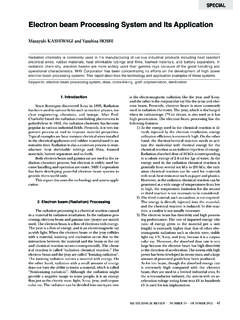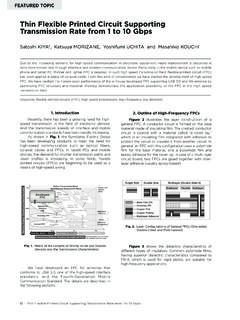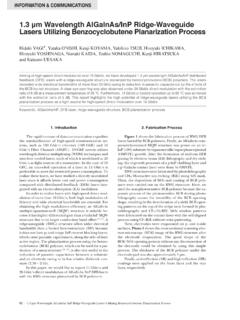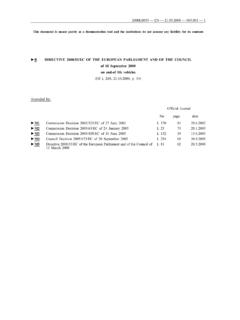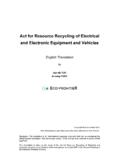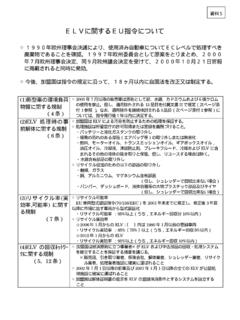Transcription of Regulations on and Management of Chemical …
1 SEI TECHNICAL REVIEW NUMBER 85 OCTOBER 2017 5 SPECIAL1. IntroductionChemical substances are indispensable for our daily life. However, they can be harmful to both human health and the environment. In order to minimize the negative impact on human health and the environment, countries regulate usage of Chemical substances, and the coverage of such Regulations has now expanded from the actual chem-ical substances themselves to substances contained in prod-ucts. This paper summarizes current trends in the regula-tion of Chemical substances in products and Chemical substances Management to comply with such Regulations Concerning Chemical Substances in Products2-1 International trends in Chemical substance regulationsIn 1992, the United Nations Conference on Environment and Development (Earth Summit) was held in Rio de Janeiro, Brazil, with the aim of achieving both global development and environmental protection.
2 The summit produced the Rio Declaration on Environment and Development and the Agenda 21, an action plan to implement principles described in the Rio Declaration, and Chapter 19 in the Agenda 21 was dedicated to Environmentally Sound Management of Toxic in 2002, the World Summit on Sustainable Development (WSSD) was held in Johannesburg, South Africa, to revise the said Agenda 21 and discuss issues newly arisen. Products from the WSSD were the Johannesburg Declaration on Sustainable Development and the Plan of Implementation of the World Summit on Sustainable Development, with the aim of minimizing negative impacts from Chemical manufacturing and usage on human health and the environment by , to clarify the action plan, the International Conference on Chemicals Management 1 (ICCM 1) was held in 2006 and the Strategic Approach to International Chemicals Management (SAICM) was adopted.
3 With the backdrop of such developments in Chemical Management , related laws and Regulations have been actively revised and renewed across the world in recent with regard to Chemical substances in products, ICCM 2 held in 2009, adopted hazardous substances within the life cycle of electrical and electronic products and Chemical substances contained in products as emerging issues. 2-2 European Regulations on Chemical substances in products(1) RoHS DirectiveIn Europe, waste electrical and electronic devices were conventionally discarded by means of landfills and incineration.
4 However, pollution from the hazardous substances, such as lead, contained in devices treated in the landfill or incineration sites became an increasing problem. To control this situation, the RoHS Directive 2002/95/EC Restriction of the Use of Certain Hazardous Substances in Electrical and Electronic Equipment was enforced in 2003 to restrict the use of six hazardous mate-rials in the manufacture of various types of electronic and electrical equipment. Later, a new legislative framework, RoHS (2011/95/EC), was adopted in 2012 stipulating creation and attachment of technical documents that verify conformance with the directive and displaying CE marking*1 on RoHS Directive specifies maximum limits of specified substances by weight in a homogenous material*2 within electrical and electronic devices, as follows.
5 Wt% (1,000 ppm) for lead, mercury, hexavalent chromium, polybrominated biphenyls (PBB), and polybrominated diphenyl ethers (PBDE) (the latter two are brominated flame retardants); and wt% (100 ppm) for of the specified chemicals beyond these maximum levels is prohibited. Further, in 2015, the revised directive was published to add the following four phthal-ates, which are mainly used as plasticizers, to restricted substances: bis (2-Ethylhexyl) phthalate (DEHP); benzyl butyl phthalate (BBP); dibutyl phthalate (DBP); and diiso-butyl phthalate (DIBP).
6 The maximum limit of these substances is wt% (1,000 ppm) and the directive will come into effect in July on and Management of Chemical Substances in ProductsTakayuki MISHIMA--------------------------------- ---------------------------------------- ---------------------------------------- ---------------------------------------- ---------------------------------------- ---------------------------------------- ----------------- Regulations on Chemical substances are being strengthened yearly in each country, and Chemical substances contained in products such as electrical and electronic equipment are subject to regulation.
7 In order to comply with such Regulations , communicating information of Chemical substances contained in products in the supply chain is necessary. For communicating information, international standards are set for electrical and electronic equipment, and construction of a mechanism for communication of information by industry groups, etc. Furthermore, in order to communicate accurate information, it is essential to manage Chemical substances at each stage of design and development, purchasing and manufacturing.
8 Chemical substances Management , RoHS Directive, ELV Directive, REACH Regulation6 Regulations on and Management of Chemical Substances in Products(2) ELV DirectiveIn the same way as the RoHS Directive for electrical and electronic devices, the ELV Directive (Directive 2000/53/EC End-of Life Vehicles) was adopted in 2000 in order to reduce environmental impact from waste vehicles. The ELV Directive specifies maximum limits of wt% (1,000 ppm) in homogeneous materials and vehicle compo-nents for lead, mercury, and hexavalent chromium, and wt% (100 ppm) for cadmium, and prohibits usage beyond these limits.
9 (3) REACH RegulationFollowing the Chemical Regulations across the world as described in the above , the EU adopted REACH (Registration, Evaluation, Authorisation and Restriction of Chemicals; Regulation (EC) 1907/2006) in 2006. REACH comprises the following Regulations : <1> Registration Mandates manufacturers and those importing chem-ical substances into the EU in quantities above 1 ton per year to register such the substances. <2> Authorisation Mandates manufacturers and those importing the designated Chemical substances to obtain authori-sation to manufacture or import the substances through application depending on their usage.
10 <3> Restriction Limits or bans the manufacture from placing the designated substances on the market or using it. <4> Information exchange Mandates manufacturers of products that contain more than wt% of Substances of Very High Concern (SVHC) to communicate information on the safe use of the products (at least a list of the substances) for downstream the above four items, restriction and informa-tion exchange concerning SVHC are Regulations that are related to Chemical substances in products.

